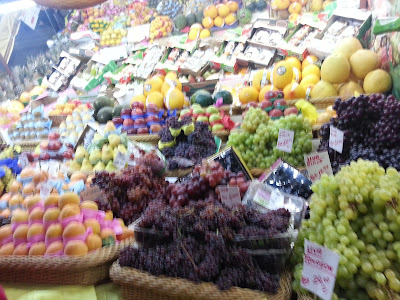Hey I'm catching up!
Me, Jorge, Kelly, Arturo, and Billy just loved this sign.
Have I introduced the caipirinha yet? The national drink of Brazil, made with cachaza (or vodka) and a fruit of your choosing. Lime is the standard, but I've also tried morango (strawberry), abacaxi (pineapple), and kiwi (kiwi).
Beautiful. They bring it out real rare and light a fire under it, you take it off when its cooked to your taste. There was carne (beef), frango (chicken), and some type of salsicha (sausage), possibly linguica ((c with a squiggle, sounds like an s)) (linguista)
We went to a famous art museum in Sao Paulo called the Pinacoteca. We had a tour guide and translator, but we really only saw two rooms out of 4 floors because they talk so much! We had a little time to roam around at the end, and so a group of us followed this odd thumping bass noise to a long dark hallway and started to walk down it. It was pitch black and the pounding was getting louder, faster and faster. We reached the end of the hall, and it opened into a small room with people sitting inside watching a flashing screen. Right as we got there tho, the show ended, and everyone emptied out. Bummer.

With the tour guide, we stared at this painting for so painfully long. Probably at least a half hour, just trying to interpret the meaning of it. It's name translates to "Sharpening, Interrupted". It's like a rural Brazilian guy who is just chillin' in the countryside, hard at work. He's just there sharpening his axe, and then what? Who's there? What do they want? What is going through this man's head? So many questions...
"Did you know?"
(Best) worst Elvis impersonator ever!
Eggs. They look normal. But when I cracked them open they had oddly bright orange yolks. Kinda freaked me out, since most other peoples' were a normal yellow. Maybe I got some kind of special eggs? Other weird thing about eggs here: They don't refrigerate them. Combination of the orange yolks and non-refrigeration had me eating 3 and tossing the other 3. They tasted okay..I think. But I didn't want to die.
Suco (juice). They have really good juices here. Sometimes they leave them unsweetened, and you add your own sugar, like we do with coffee. Brazilians love things really sweet.
I got some fruits at the supermercado, including carambola (starfruit). Came out pretty good.
This was one of the best burgers I've ever had. At the Acai cafe place near our school here, I ordered a burger. It came out with a fried egg, two different kinds of cheese, and a bunch of other good stuff on there. I might have to get another one before I leave. Soo good.
Walked into a store that had a lot of dried fruits, wine, cheeses, meats, fish etc. Looked really good, but we were on the way to our samba class or something probably, so I didn't get anything.
Fruit pastes. Like a really sweet jam kind of. Guarana is a common one.
Passing underneath the metro station on the way to the Latin American history museum
Check out this piece of art. That blood is dripping in the shape of Central and South America. Deep.
Sweet diving board?
View of the square from behind the hand in the late afternoon
Supposed to look like a flower from some angle...
Cool looking bridge. Supposed to look like a swam.
We went inside this building. It was huge, all one big vast room. It had these huge stone pillars that told the history pictorally of each of the peoples that came to be in Brazil. I would have taken pictures, but it wasn't allowed.
By far the coolest thing in the Latin American history museum. This see through floor which featured a large but intricate model map of South and Central America. So cool!
This is Sao Paulo (left) and Rio de Janiero (right)
Mayan temples!
The Panama Canal!
Machu Pichu!
Joe, Kelly, and Emily, with the big hand in the background
Ahh the rodizio! Best buffet ever. Brazilian steakhouse style, there are constantly waiters bringing around hunks of various meats, and if you want it, they'll slice a piece off for you. Pretty fancy, and really really good food. And the price translates to less than $18 US. That kind of meal in Boston would be triple that probably, and not even the real thing.
First course. I tried as many things as I could, without filling up. There was lobster stroganoff in there. Had to save room for the meat coming around.
The first of many many little plates of meat. Different cuts of beef, cooked however you like, sausage, chicken, lamb, and I can't even remember what else. Oh yeah, I tried chicken hearts.
Pretty good buffet of sushi too. They have sushi places everywhere down here from all the Japanese influence. They even had the little seeds you can put on there, and the sweet eel sauce that goes with it, which is one of the tastiest sauces ever. Also, I loaded my soy sauce up with wasabi. It was a more liquidy kind of wasabi, not like what you usually see in the U.S.
Some people capped off dinner with a dessert of creme brulee, torched right on the table. I tried a bite. Wicked good.

Back to the Ibirapuera Parque for our picnic!
Like I said, this park has everything for everyone. 11 times bigger than the Boston Common, it is the second largest and most popular park in Sao Paulo. This large covered concrete pad is for anything with wheels, so you see lots of skateboarders, longboarders, roller skaters, and casual bikers hanging out.
We ate by the waters edge. We had sandwiches made by Chef Harrison, and 4 bottles of wine that we killed between the 7 of us. Really good group and a fun time.
The fountains turned on for us during our picnic! They're not the Bellagio fountains, but they were pretty good, and there was one spout that shot up super high!
Soleil, Harrison, Jared, Kelly, Sunny, and Emily
We threw bread crumbs to the fish and they would grab it within a few seconds! A duck came over too, and we made them race to the food.
We stayed till sunset
The long exposure time of my camera's night setting actually makes this look cool!
Their packaging tells you how long to keep things, and what temp to store them at.
Saturday night pub crawl time!!! We went to four different places. This is Joe, Hayley, and Arturo at the second one.
Making new friends! (Who are these people?) haha
Just priceless. haha People liked talking to us, even just to practice their English I think!
Jared, Hayley, Emily, Kelly, and Arturo
Lia, Jordan, Soleil, and Rachel
This is the third place! It was a dancing bar, and at one point there was a group line dance that we had never heard and we just tried to go along with it!
After this, we got a drunk bus and drove to Club Clash, an electronic music club. Jared and I talked to a couple guys in line and ended up adding them on facebook. haha We didn't stay at the club that long though, since we got tired by then, and the bass was practically punching holes in my body.
We got up the next morning and went biking! Sao Paulo has an awesome thing they do every Sunday where they cone off the bike lane and a ton of people go for a casual Sunday ride! They actually have slower speed limits on Sundays, and they have people at every intersection with flags guiding the bikers around. It's really cool, I wish we had this in Boston! The bike rentals were really cheap too, only R $ 6,00/hr, (less than $3US/hr)
What?? Elvis again? Yep!
Stopped at a red light on Avenue Paulista, the main drag here in Sao Paulo, with all the big financial institutions and high class shopping. Notice the bike lane coned off, and the guy under the umbrella on the left, holding the red flag down to keep us from running the red light.
Hmm. Interesting.
Quite a few homeless people under this bridge in the park
Mollie realizing that the great timer picture that she set up of us on our bikes didn't save because she forget to put her memory card back in. #Fail
Soggy gnocchi with green peppers and tomato sauce. Not my best creation :(
We went to Independence Park to learn more about the history of Brazil. I won't bore you with the details of it (or I just don't remember...haha) but a few points: Brazil was settled by the Portuguese and was a huge asset for them. Brazil declared independence in 1822, and this monument was built in 1922 to celebrate their centennial. The name Brazil came from the Brazil tree, from which an important dye was extracted. Brazil brought over Africans from Mali, Nigeria, and Cameroon and sold them into slavery, similar to the U.S. Brazil outlawed slavery in 1888, just 125 years ago.
Interesting bit about this monument--We noticed that the horsed men carrying swords had the swords missing, leaving just the handle. We thought this was from either vandalism or wear and tear, but it turns out they were actually cut as a form of protest, for when Brazil was under the control of a military dictatorship from 1964 to 1985. Pretty cool.
Old house made from mud























































































































